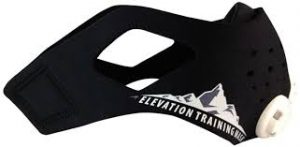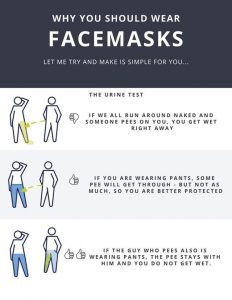Will You Die If You Wear a Mask While Working Out?
Short answer: No, of course not. What kind of silly question is that?
Long answer: rest of this post.
With many gyms beginning to slowly re-open, and many jurisdictions still preventing them (including Alberta), there’s a lot of discussion about how to re-open while limiting the spread or potential risk of spread, and one of the main options presented is the use of masks or face coverings at all times while in a gym.
This has obviously been met with some resistance from a lot of people, claiming it’s a violation of their freedoms to saying people have died while exercising in a mask because it causes hypercapnia (excess CO2 build up in the blood) and prevents oxygen from being inhaled.
So today I wanted to break down some of the physics, physiology, and potential ways to re-introduce exercise with a mask or face covering in a way that would be considered safe, effective, and likely least uncomfortable as possible, by running through some big questions and scenarios
- Do Masks Cause Hypercapnia and Hypoxia?
When you work out, you increase the rate of oxygen use and carbon dioxide production to manage the increased work load. You exhale to get rid of the carbon dioxide and inhale to get new oxygen in. A mask is a physical barrier that would alter how much of each gets moved in and out on each respiratory cycle. It would be feasible to think a face covering would prevent you from exhaling fully and clearing out the carbon dioxide from your lungs, but that often isn’t the case.
There are a ton of exercise-specific masks already commercially available and have been for decades, specifically for exercise in extreme environments. Runners in very cold temperatures (hi Edmonton) wear face coverings to ensure their face doesn’t get frost bite, but also to prevent their lung tissue from being damaged by inhaling extremely cold air. As their runs progress, the exhalations carrying higher moisture contents can cause the moisture to freeze on the mask, making an always hilarious frosty face, but also causing the ability to move air to be reduced as the covering becomes frosted over.

Similar face coverings are worn during exercise in extreme heat and when there’s a lot of pollutants (dust, pollen, sand, etc), so it’s not just exclusive to those of us who live where the air will kill you for half of the year.
These masks are typically made of a highly breathable material that doesn’t restrict air flow as much, but are still beneficial for preventing respiratory droplets, the main delivery mechanism for viral particles, from being propelled from someone who’s a carrier into the general public, and also acts as a barrier for you from inhaling someone else’s respiratory particles. A good analogy, not wearing anything on your face is like walking outside without any shoes, whereas this kind of mask is like wearing flip flops. Some level of protection, but not going to allow you to rock out in more at risk scenarios.
Next in terms of airway limits, elevation masks. Remember those? Yeah, masks, designed to limit airflow, specifically for the purpose of creating metabolic stress from hypercapnia and hypoxia, while also training your respiratory muscles.

These PURPOSELY restrict airflow, essentially making it harder to get in oxygen and exhale carbon dioxide. They don’t do much to filter the air, just create a smaller aperture through which to move air.
THIS GUEST POST on Tony Gentilcore’s site by Dan Hechler and James Darley does a great job outlining the existing science on the use of these, so I’ll just refer there for if they’re useful or not.
Now as they just alter how much airflow you have access to, they won’t directly prevent you from inhaling someone’s respiratory droplets, but a cheap fix for that is to just add in a replaceable charcoal filter, which are pretty inexpensive to do.
So if exercising intensely in one of these doesn’t cause hypercapnia or hypoxia to a point where a persons’ life is at risk, the argument that a face covering can cause hypercapnia is kind of blown out of the water from these already existing masks that purposefully try to do that very thing for exercise benefits.
To continue the footwear analogy, these kinds of masks would be like walking outside in some Crocs or other slip on kind of shoe.
Let’s say someone wants to step up their game and go for even more intense and extreme face coverings. In many commercial, industrial and military settings, N95 masks are used to filter out particulates and keep the wearer safe, and in many of those activities they are still very physically demanding, so the exercise component itself is not really the concern for many.

N95 masks aren’t exclusively made for medical settings, but are very commonly used in medical settings. THIS SITE gives a good breakdown of what they are and how they’re made, but essentially they’re standardized to allow 0.3 micron filtration and are 95% efficient at filtering these particulates. For anyone in industrial settings where there’s a lot of airborn particulates, that’s a good thing to have.
The medical grade N95s are a bit different, but use the same material and have the same ratings, but prior to pandemics you could get N95 masks at your local automotive supplies store or even at farm equipment retailers, so they’re not specifically the domain of medical use.
Do these cause hypercapnia? Directly, not more than usual exercise, but they do have an impact on gas exchange at relative intensities and alter anaerobic thresholds.
This study from 2015 looked at low level aerobic exercise (3 MET) in pregnant women (!!) and found that while tidal volume (total amount of air breathed) was lower with a mask, total inspired oxygen and carbon dioxide were roughly the same as non-mask controls, lowered VO2 at matched intensities by 13.8%, but also lowered VCO2 by 17.7%. One thing to note though, is that the subjects appeared to adapt to the workload relatively quickly with no specific increase in blood lactate or symptoms of intolerance. In other words, their physiology switched metabolic processes during exercise with a mask to allow them to continue moving without becoming hypoxic or hypercapnic. It was an additional stressor compared to non-mask wearing controls, but it wasn’t unmanageable.
Looking at the other end of the spectrum, fire fighters routinely have to engage in physically demanding work, while wearing full safety suits, and industrial respirators. In maximal cardio testing with boots and personal protective gear, fire fighters tested had a reduced overall VO2 max compared to wearing shoes and/or no PPE, but didn’t go hypercapnic or hypoxic, in spite of maximal cardio testing protocols.
While fire fighters often have SCBA set ups to provide oxygen, many will tell you it’s never as easy to wear as to exercise without one, and they still give restrictions to ease of breathing.
Even comparing elevation masks to SCBA apparatus during max intensity or very high effort intervals, THIS STUDY (from Edmonton too!) showed using a restrictive training mask provided significant training benefits and physiological outcomes for firefighters working at matched work outputs. In measured inspiratory, expiratory, and cardiologic adaptative effects, no adverse hypercapnic or hypoxic effects were seen, so I guess the idea of a cloth mask causing you to die is itself dead in the water.
For the shoe analogy, these are your heavy duty hiking boots, good for all terrains and surfaces, but cumbersome and uncomfortable after a while. Not likely to kill you, but maybe a blister here or there.
In many military settings, physical training in special assignments has to be done with some form of mask, or certain missions are carried out with intense face coverings or respirators. I’m not an expert on what they would wear or when, but I’m sure some who have served could think of a few situations like this.
With all this data, you likely won’t die if you wear a mask when exercising, especially if it’s not a high end industrial or medical grade mask. A simple disposable paper or reusable cloth mask won’t prevent air exchange while still giving some protection from inhaling or exhaling respiratory droplets that could contain viral particulates.
2. Is It a Government Conspiracy?
I always love the mental gymnastics people play in conspiracy theories. It’s quite fascinating. For instance, wearing a mask is a sign of obedience to a government agency that just wants fascist control over citizens. By letting them wear clothing. Cool
Let’s flip this on it’s head.
Wearing a mask and preventing exposure to a virus will help you avoid having to have the inevitable vaccine, which many believe is a way of exerting population control. Strike one, fascisms!
Many government and corporate organizations are including facial recognition software in public places. What better way to avoid being tracked by the government than by wearing a face covering? Strike two!
By exercising in a face covering that provides some metabolic stress and breathing muscle training, you’ll be in better cardiovascular shape, which will help improve lung tissue health and ward off possible severe symptoms of infections. STRIKE THREE BITCHES!
TL:DR, no, it’s not a government conspiracy. Have you seen our collective governments? You really think they’re smart enough to pull something off on that scale? You think Big Pharma wants you to make your own masks for free versus getting jabbed with one of their products?
3. Is It More Uncomfortable to Wear a Mask When Exercising?
As with any piece of clothing, when you move to something new it’s going to take some time to adjust to it, but after a while you likely won’t even notice it.
Think about the last time you changed the style or type of underwear you use. If you went from some to none, or from none to some, or went to boxers, briefs, panties, or something I’ve never even seen or heard of before, it was likely a bit of discomfort associated with the change for a brief period, but I’m sure there were parts of each day where you weren’t even thinking about them, and likely forgot you were wearing them. or weren’t wearing them. I don’t judge, you do you.
Similarly to wearing a mask while exercising, I know a lot of my clients who run in the winter forget they have one on after a while and just truck on with their own lives.
In closing, no, you likely won’t die from wearing a mask while exercising. I’m sure you’ve seen some unverified claims that someone somewhere died while exercising wearing a mask, but that begs a lot of questions. Did they have underlying health conditions like exercise-induced asthma and didn’t have a rescue inhaler on them? How intense was the exercise session, and had they had any time to accommodate to wearing the mask while working out? Was it a verified story or just an urban legend or some form of disinformation?
We do know that people have worn a multitude of masks during exercise, physical labour, and all sorts of intensities of physical exertion with no reason to believe the mask was causing problems that weren’t manageable, and have done so for DECADES. A simple face covering won’t completely eliminate the risk of transmission, but it can significantly reduce it. Couple that with sanitizing any and all equipment regularly, maintaining social distancing, and you can expect to be able to crush your workouts hard with minimal risk soon enough.
